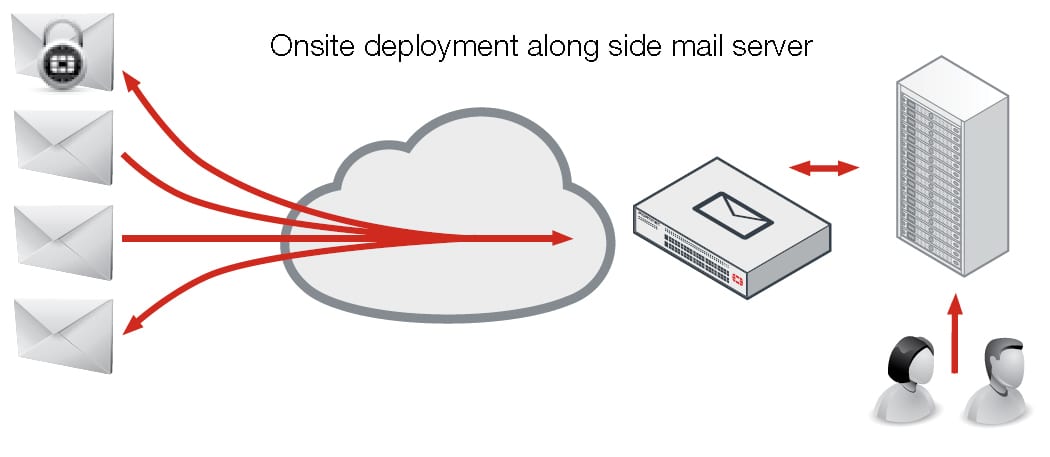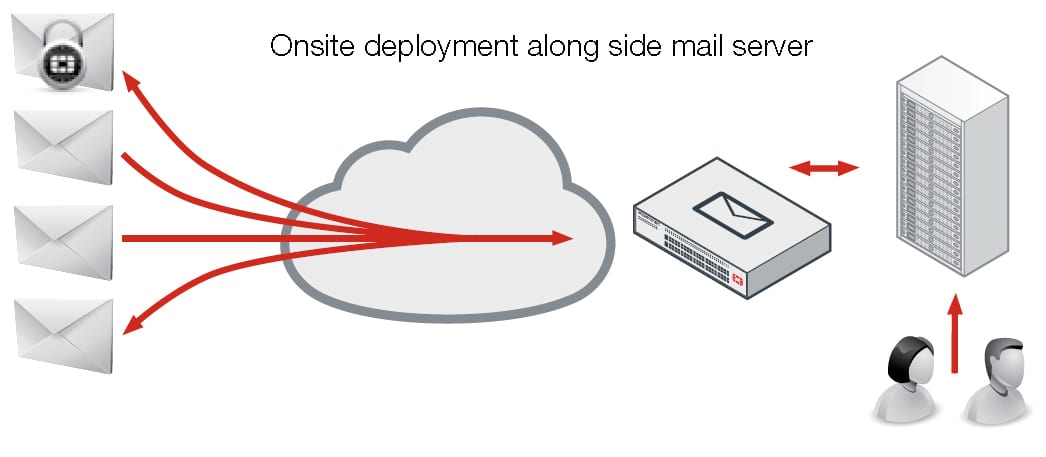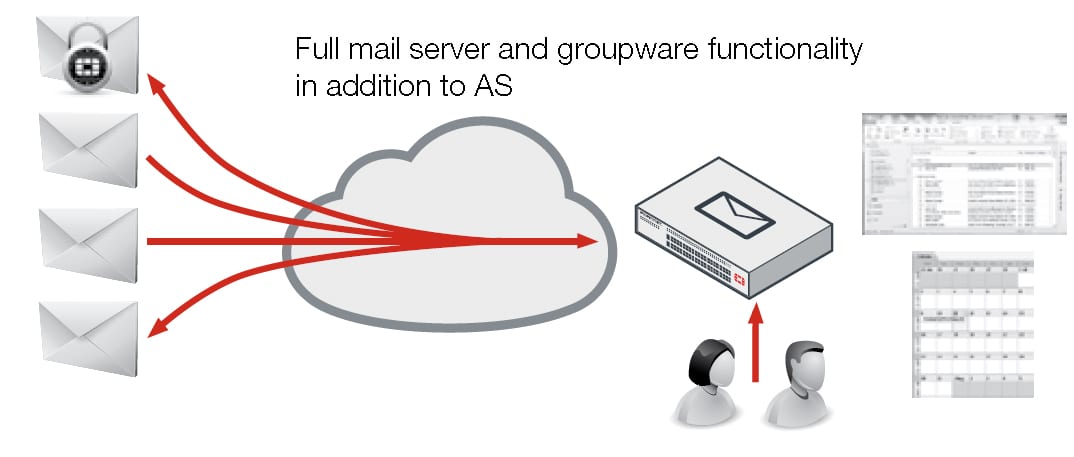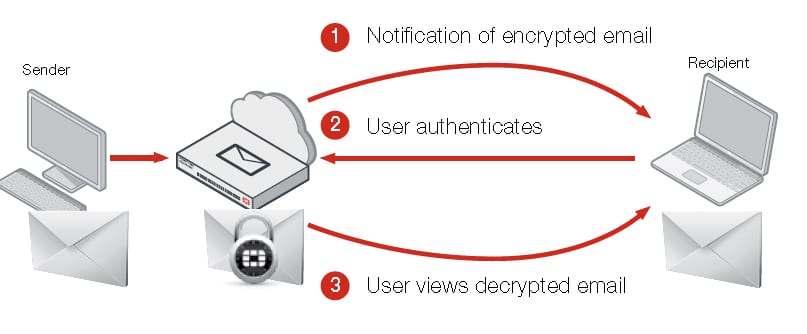Email: [email protected] Ligue agora! +55-11-3717-5537
FortiMail appliances and virtual appliances are proven, powerful email security platforms for any size organization — from small businesses to carriers, service providers, and large enterprises. Purpose-built for the most demanding messaging systems, FortiMail appliances employ Fortinet’s years of experience in protecting networks against spam, malware, and other message-borne threats.
FortiMail prevents your email systems from becoming threat delivery systems. Its inbound filtering engine blocks spam and malware before it can clog your network and affect users. Its outbound inspection technology prevents other antispam gateways from blacklisting your users by blocking outbound spam and malware, including mobile traffic.
Enforce secure content delivery with FortiMail Identity-Based Encryption (IBE), S/MIME, or TLS email encryption options. Prevent accidental and intentional loss of confidential data using predefined HIPAA, GLBA, SOX or customized dictionaries.
FortiMail appliances provide high-performance email routing and security by utilizing multiple high-accuracy antispam filters. When coupled with industry leading real-time antivirus and antispyware protection from FortiGuard Services, FortiMail provides you with extremely fast and accurate email security that won’t affect end users or delay their communications. FortiMail can be deployed in the cloud or on premises and gateway, inline and server modes in a range of appliance or virtual machine form factors. This flexibility allows you to deploy FortiMail in the mode that best suits your environment.
In addition to FortiGuard antivirus, FortiMail supports on-board code emulation to identify and block suspicious files based on their intended behavior. Optional cloud-based or on-premise “sandboxing” provide a full, contained, run-time environment to thwart the highly targeted and tailored attacks that increasingly bypass traditional defenses. Rich threat intelligence, actionable insight and the option to share information with FortiGuard Labs in order to receive automated protection updates help organizations reduce the risk of compromise and breach from such sophisticated attacks.
| Flexible Deployment Options | FortiMail can be deployed in gateway, transparent mode and as a fully featured mail server. With hardware, VM and cloud form factors, FortiMail is flexible enough to cater to every customer requirement. |
| Apply Data Loss Prevention and Identity-Based Encryption | Detect sensitive information using defined data patterns and ensure secure delivery with no additional hardware or software to install, no user provisioning, no recipient pre-enrollment. |
| Prevent Phishing and Other Advanced Threats | Apply embedded URL inspection, top rated antimalware and optional sandbox integration to detect highly targeted attacks. |
| Identify and Block Spamming Endpoints | Carriers and Service Providers, prevent blacklisting of legitimate subscribers by identifying and blocking endpoints sending spam. |
| No Per-User or Per-Mailbox Pricing | Complete, multi-layered antivirus, antispam, antispyware and antiphishing protection for an unlimited number of users. Greatly reduces TCO. |
System
Antivirus
Content-Based Protection
|
Management, Logging, and Reporting
High Availability (HA)
Denial-of-Service Protection
Gateway Encryption
|
Antispam Profile
Server Mode Specific Features
|
Choose from three modes of deployment — Transparent, Gateway, or Server mode – to meet your specific email security requirements, while minimizing infrastructure changes and service disruptions:
Gateway Mode: Provides inbound and outbound proxy mail transfer agent (MTA) services for existing email gateways. A simple DNS MX record change redirects email to FortiMail for antispam and antivirus scanning. The FortiMail device receives messages, scans for viruses and spam, then relays email to its destination email server for delivery.

Transparent Mode: Each network interface includes a proxy that receives and relays email. Each proxy can intercept SMTP sessions even though the destination IP address is not the FortiMail appliance. FortiMail scans for viruses and spam, then transmits email to the destination email server for delivery. This eliminates the need to change the DNS MX record, or to change the existing email server network configuration.

Server Mode: The FortiMail device acts as a stand-alone messaging server with full SMTP email server functionality, including flexible support for secure POP3, IMAP and WebMail access. FortiMail scans email for viruses and spam before delivery. As in Server mode, external MTAs connect to FortiMail, allowing it to function as a protected server.

Identity-Based Encryption (IBE) IBE allows FortiMail to deliver confidential and regulated email securely — without requiring additional hardware, software user provisioning, or extra license fees. Use IBE to eliminate paper-based communications and reduce costs.
Policy-Based Encryption: Automatically encrypt messages for compliance, based on content or recipient.
Push or Pull Mode: Use Push, Pull, or a combination of modes to meet your requirements.
Easy to Deploy, Use, and Manage: Deploy IBE in any mode, including Transparent mode, without user provisioning or additional hardware or software.

| FORTIMAIL 60D | FORTIMAIL 200D | FORTIMAIL 400C | |
|---|---|---|---|
| Suggested Deployment Scenarios | |||
| Demo, testing, training and small enterprise use with fewer than 100 users* | Small businesses, branch offices, and organizations with fewer than 400 users* | Small-to-midsized organizations with up to 1000 users* | |
| Hardware Specifications | |||
| 10/100/1000 Interfaces (Copper, RJ-45) | 4 | 4 | 4 |
| SFP Gigabit Ethernet Interface | 0 | 0 | 0 |
| Redundant Hot Swappable Power Supplies | No | No | No |
| Storage | 1x 500 GB | 1x 1 TB | 2x 1 TB |
| RAID Storage Management | No | No | Software: 0, 1 |
| Form Factor | Desktop Appliance | Rack Mount Appliance | Rack Mount Appliance |
| System Specification | |||
| Configured Domains ** | 2 | 20 | 100 |
| Recipient-based Policies (per Domain / per System)— Incoming or Outgoing | 15 / 30 | 60 / 300 | 600 / 3000 |
| Server Mode Mailboxes | 50 | 150 | 400 |
| Antispam, Antivirus, Authentication, and Content Profiles (per Domain / per System) | 10 / 15 | 50 / 60 | 50 /200 |
| Performance (Messages/Hour) [Without queuing based on 100 KB message size] | |||
| Email Routing | 3.6 K | 76 K | 150 K |
| FortiGuard Antispam | 3.1 K | 68 K | 140 K |
| FortiGuard Antispam + Antivirus | 2.7 K | 58 K | 120 K |
| Dimensions | |||
| Height x Width x Length (inches) | 1.61 x 8.27 x 5.24 | 1.75 x 17.05 x 13.86 | 1.70 x 17.10 x 14.30 |
| Height x Width x Length (mm) | 41 x 210 x 133 | 45 x 433 x 352 | 44 x 435 x 364 |
| Weight | 2.6 lbs (1.2 kg) | 13.4 lbs (6.1 kg) | 16.1 lbs (7.3 kg) |
| Environment | |||
| Power Source | External Power Supply 19V DC 2.1A 40 W | 100–240V AC, 50–60 Hz | |
| Maximum Power Required | 20 W | 1.00A / 110V, 0.50A / 220V | 4.00A / 110V, 2.00A / 220V |
| Power Consumption (Average) | 24 W | 60 W | 100 W |
| Heat Dissipation | 78 BTU/h | 205 BTU/h | 342 BTU/h |
| Humidity | 10–90% non-condensing | 5–95% non-condensing | 10–90% non-condensing |
| Operating Temperature | 32–104°F (0–40°C) | 32–104°F (0–40°C) | 32–104°F (0–40°C) |
| Storage Temperature | -13–158°F (-25–70°C) | -13–158°F (-25–70°C) | -4–158°F (-20–70°C) |
| Compliance | |||
| FCC Part 15 Class B, C-Tick, VCCI, CE, UL/cUL, CB | FCC Part 15 Class A, C-Tick, VCCI, CE, UL/cUL, CB | ||
| Certification | |||
| VBSpam and VB100 rated | VBSpam and VB100 rated, Common Criteria EAL 2+, FIPS 140-2 Validation | ||
** Suggested sizing for Gateway and Transparent deployments. For Server Mode, see Server Mode Mailbox metric. If unsure, please validate the model selection by checking the peak mail flow rates and average message size detail with a FortiMail specialist.
** Configured domains is the total number of email domains that can be configured on the appliance. Domain Associations can be used to enable additional domains which share configuration with the primary domain to which they are assigned.
| FORTIMAIL 1000D | FORTIMAIL 3000C | FORTIMAIL 3000D | |
|---|---|---|---|
| Suggested Deployment Scenarios | |||
| Mid to large enterprise, education and government deparments with up to 3000 users* | Universities, Large enterprise, ISP, Carrier | Highest performing appliance for the largest University, corporate, ISP and carrier customers | |
| Hardware Specifications | |||
| 10/100/1000 Interfaces (Copper, RJ-45) | 6 | 4 | 4 |
| SFP Gigabit Ethernet Interface | 2 | 2 | 2 |
| Redundant Hot Swappable Power Supplies | Yes | Yes | Yes |
| Storage | 2x 2 TB (2x 2 TB Optional) | 2x 1 TB (4x 1 TB Optional) | 2x 2 TB (6x 2 TB Optional) |
| RAID Storage Management | Hardware: 1, 5, 10, 50, Hot Spare (Based on Drive Count) | Hardware: 1, 5, 10, 50, Hot Spare (Based on Drive Count) | Hardware: 1, 5, 10, 50, Hot Spare (Based on Drive Count) |
| Form Factor | Rack Mount Appliance | Rack Mount Appliance | Rack Mount Appliance |
| System Specification | |||
| Configured Domains ** | 800 | 2000 | 2000 |
| Recipient-Based Policies (per Domain / per System)— Incoming or Outgoing | 1,500 / 7,500 | 1,500 / 7,500 | 1,500 / 7,500 |
| Server Mode Mailboxes | 1500 | 3000 | 3000 |
| Antispam, Antivirus, Authentication, and Content Profiles (per Domain / per System) | 50 / 600 | 50 / 600 | 50 / 600 |
| Performance (Messages/Hour) [Without queuing based on 100 KB message size] | |||
| Email Routing | 680 K | 900 K | 1.2 M |
| FortiGuard Antispam | 620 K | 830 K | 1.1 M |
| FortiGuard Antispam + Antivirus | 500 K | 730 K | 1.0 M |
| Dimensions | |||
| Height x Width x Length (inches) | 3.46 x 17.24 x 14.49 | 3.46 x 17.40 x 29.00 | 3.46 x 18.99 x 29.00 |
| Height x Width x Length (mm) | 88 x 438 x 368 | 88 x 442 x 737 | 88 x 482 x 737 |
| Weight | 57.5 lbs (26.1 kg) | 50.0 lbs (22.7 kg) | 71.5 lbs (32.5 kg) |
| Environment | |||
| Power Source | 100–240V AC, 50–60 Hz | ||
| Maximum Power Required | 3.50A /110V, 1.75A /220V | 7.0A / 110V, 3.5A / 220V | 10.0A / 110V, 5.0A / 220V |
| Power Consumption (Average) | 115 W | 200 W | 340 W |
| Heat Dissipation | 471 BTU/h | 683 BTU/h | 1160 BTU/h |
| Humidity | 5–95% non-condensing | 5–95% non-condensing | 20–90% non-condensing |
| Operating Temperature | 32–104°F (0–40°C) | 50–95°F (10–35°C) | 50–95°F (10–35°C) |
| Storage Temperature | -13–158°F (-25–70°C) | -40–149°F (-40–65°C) | -40–149°F (-40–65°C) |
| Compliance | |||
| FCC Part 15 Class A, C-Tick, VCCI, CE, UL/cUL, CB | FCC Part 15 Class A, C-Tick, VCCI, | CE, BSMI, KC, UL/cUL, CB, GOST | |
| Certification | |||
| VBSpam and VB100 rated | VBSpam and VB100 rated, Common Criteria EAL 2+, FIPS 140-2 Validation | VBSpam and VB100 rated | |
** Suggested sizing for Gateway and Transparent deployments. For Server Mode, see Server Mode Mailbox metric. If unsure, please validate the model selection by checking the peak mail flow rates and average message size detail with a FortiMail specialist.
** Configured domains is the total number of email domains that can be configured on the appliance. Domain Associations can be used to enable additional domains which share configuration with the primary domain to which they are assigned.
| Technical Specifications for FortiMail Virtual Appliances | VM00 | VM01 | VM02 | VM04 | VM08 |
|---|---|---|---|---|---|
| Suggested Deployment Scenarios | |||||
| Demo, testing, training and small enterprise use with fewer than 100 users* | Small businesses, branch offices, and organizations with fewer than 400 users* | Small to midsized organizations with up to 1000 users* | Mid to large enterprise with up to 3000 users* | Large enterprise | |
| Technical Specifications | |||||
| Hypervisors Supported | VMware ESXi / ESX 4.1 / 5.0 / 5.1 / 5.5 | ||||
| Virtual Machine Form Factor | Open Virtualization Format (OVF) | ||||
| Maximum Virtual CPUs Supported | 1 | 1 | 2 | 4 | 8 |
| Virtual NICs Required (Min/Max) | 1/4 | 1/4 | 1/4 | 1/4 | 1/4 |
| Virtual Machine Storage Required (Min/Max) | 50GB / 1TB | 50GB / 1TB | 50GB / 2TB | 50GB / 4TB | 50GB / 8TB |
| Virtual Machine Memory Required (Min / Max) | 1GB / 2GB | 1GB / 2GB | 1GB / 4GB | 1GB / 8GB | 1GB / 16GB |
| Performance (Messages/Hour) [Without queuing based on 100 KB message size] ** | |||||
| Email Routing | 3.6K | 34K | 67K | 306K | 675K |
| FortiGuard Antispam | 3.1K | 30K | 54K | 279K | 630K |
| FortiGuard Antispam / Antivirus | 2.7K | 26K | 52K | 225K | 585K |
| System Specifications | |||||
| Email Domains | 2 | 20 | 100 | 800 | 2,000 |
| Recipient-Based Policies (Domain / System) — Incoming or Outgoing | 15 / 30 | 60 / 300 | 600 / 3,000 | 1,500 / 7,500 | 1,500 / 7,500 |
| Server Mode Mailboxes | 50 | 150 | 400 | 1,500 | 3,000 |
| Antispam, Antivirus, Authentication, and Content Profiles (per Domain / per System) | 10 / 15 | 50 / 60 | 50 / 200 | 50 / 600 | 50 / 600 |
*** Suggested sizing for Gateway and Transparent deployments. For Server Mode, see Server Mode Mailbox metric. If unsure, please validate the model selection by checking the peak mail flow rates and average message size detail with a FortiMail specialist.
*** Hardware dependent. Indicative figures based on multiple VMs running on a shared system.
*** Configured domains is the total number of email domains that can be configured on the appliance. Domain Associations can be used to enable additional domains which share configuration with the primary domain to which they are assigned.